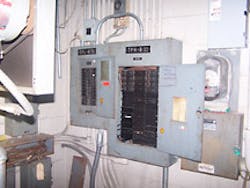As usual, never consider the following commentary associated with these photos as a formal interpretation of the National Electrical Code (NEC). Without criticizing anyone or any product, the following scenarios present us with serious safety questions.
All references are based on the 2005 NEC.
FLY-BY-NIGHT WORK
An electrical engineer working on a large remodeling project at a major U.S. airport on the East Coast recently sent in these photos. The list of Code violations and poor workmanship at this site include: missing covers that were long lost and nowhere to be found; exposed live wiring; use of improper fittings; unsupported cables; open time switch and obstructions; and an open ballast compartment in the fluorescent fixture. This situation shows a lack of proper and qualified supervision or maintenance — not to mention concern for electrical safety.
In properly completed installations, panelboard covers must be installed and panel directories properly filled out per 110.22 and 408.4. As per 408.4, “Every circuit and circuit modification shall be legibly identified as to its clear, evident, and specific purpose or use. The identification shall include sufficient detail to allow each circuit to be distinguished from all others. The identification shall be included in a circuit directory that is located on the face or inside of the panel door in the case of a panelboard, and located at each switch on a switchboard.”
I imagine our anonymous electrical designer will recommend that most of this mess be replaced. When they do replace the luminaire at this site, it will be subject to the requirements of 410.73(G), which has an effective date of Jan. 1, 2008. This new rule requires that all fluorescent luminaires that use double-ended lamps and contain ballasts that can be serviced in place or ballasted luminaires that are supplied by multi-wire branch circuits and contain ballasts that can be serviced in place have a local disconnecting means for use when servicing the luminaire in place. Note: there are some exceptions to this rule.
Found a Code violation? E-mail your text and photos to Joe Tedesco at [email protected]. Please do not send in low-resolution images, such as those typically taken with a cell phone camera.
About the Author
Joe Tedesco
Tedesco served the industry in many roles during his career. He was a director, senior electrical code instructor for National Technology Transfer, Inc. and American Trainco, Inc.. He was also a codes, standards and seminar specialist for the International Association of Electrical Inspectors and an electrical field service specialist for the National Fire Protection Association in Quincy, Mass. He ran his own business as an NEC consultant and is a Massachusetts licensed master electrician and journeyman electrician and certified electrical inspector (one and two family 2A; General 2B, and Plan Review, 2C). Tedesco also wrote articles for CEE News and EC&M (Code Violations Illustrated and What's Wrong Here?) for more than 15 years and helped launched the Moving Violations video series.
